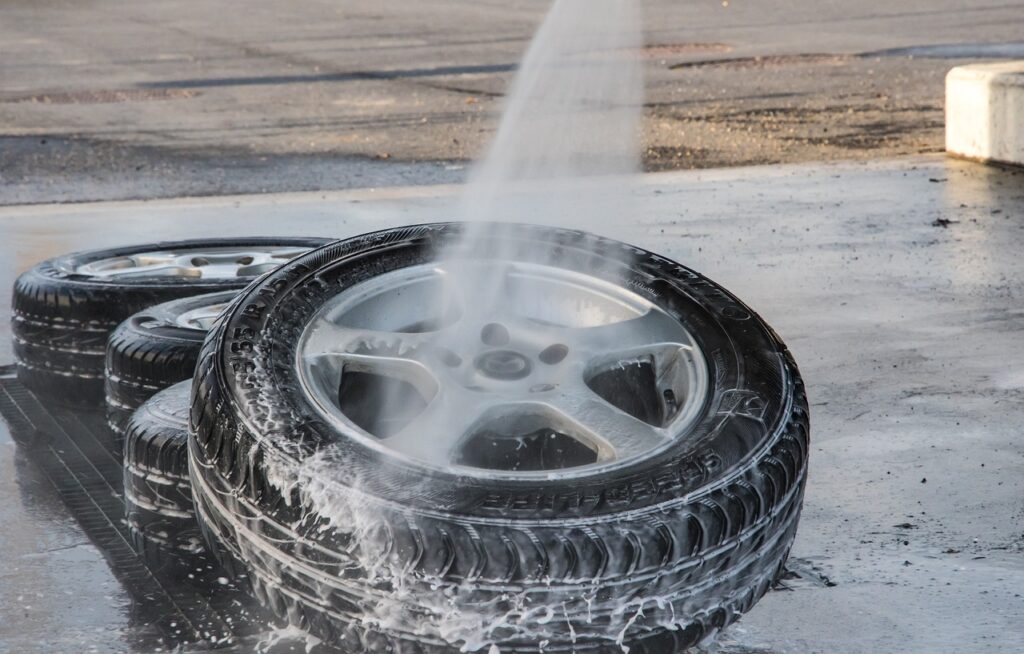Have you ever wondered how to tell if your tires are overinflated or underinflated? Well, look no further! In this article, we will explore the signs that can help you identify whether your tires are too full or not filled enough. By paying attention to these indicators, you can ensure that your tires are properly inflated, which is crucial for both your safety and the overall performance of your vehicle. So, let’s dive in and decode the language of our tires!
Signs of Overinflated Tires
Uneven Tire Wear
One of the primary signs that your tires are overinflated is uneven tire wear. When your tires have too much air pressure, they tend to wear down more quickly and unevenly. This is because the excess air pressure causes the center of the tire tread to make more contact with the road surface, leading to excessive wear in the middle of the tire. On the other hand, the shoulders of the tires may experience less contact with the road, resulting in less wear towards the edges. If you notice that your tires are wearing down in an uneven pattern, it’s a clear indication that they are overinflated.
Harsh Ride
Another sign that your tires are overinflated is a harsh and uncomfortable ride. When there’s too much air in your tires, the increased stiffness reduces the tire’s ability to absorb shocks and bumps on the road effectively. As a result, you’ll experience a rougher and more rigid ride, and the vibrations from uneven road surfaces will be transmitted directly to your vehicle’s suspension system. If you find yourself feeling every single bump on the road or your drive feels excessively bumpy, it may be a good idea to check your tire pressure.
Increased Road Noise
Overinflated tires can also contribute to increased road noise. The excessive air pressure causes the tire to ride on a smaller portion of the tread, which results in a narrower contact patch with the road surface. As a result, the tire’s grip and ability to cushion the ride are compromised, resulting in more road noise being transmitted into the cabin of your vehicle. If you’ve noticed that your car seems much louder than usual when driving, it’s worth considering that overinflated tires could be the cause.
Reduced Traction
A crucial sign of overinflated tires is reduced traction. When your tires have too much air pressure, the smaller contact patch with the road surface diminishes the tire’s ability to grip the road effectively. This can result in reduced traction, particularly in wet or slippery conditions, which can be dangerous and increase the risk of skidding or losing control of your vehicle. If you find your car sliding or slipping more easily than usual, it’s essential to check your tire pressure as overinflation may be the cause.
Decreased Fuel Efficiency
Overinflated tires can have a negative impact on your vehicle’s fuel efficiency. When tires have excessive air pressure, they tend to have a smaller contact patch with the road, leading to increased rolling resistance. This means that the engine needs to work harder to propel the vehicle forward, resulting in higher fuel consumption. If you’ve noticed a sudden decrease in your vehicle’s fuel efficiency or an increase in your trips to the gas station, it’s worth considering that overinflated tires might be to blame.
Bulging or Cracking Sidewalls
Inspecting your tire sidewalls is a crucial part of tire maintenance, and it can also help you identify if your tires are overinflated. Overinflation puts excess strain on the sidewall of the tire, causing it to bulge outward. If you notice any bulging or protrusions along the sidewall, it’s a clear indication that your tires have too much air pressure. Furthermore, overinflation can also lead to cracking or splitting in the sidewall, which is a sign of potential tire failure and should be addressed immediately. Regularly checking your tire sidewalls for any abnormalities can help ensure your safety on the road.
Unusual Tire Pressure Fluctuations
If you’re consistently experiencing unusual fluctuations in your tire pressure, it could be a sign that your tires are overinflated. Overinflation can cause the air pressure inside the tires to rise to higher levels than recommended. As a result, you may notice that the tire pressure monitor system in your vehicle frequently alerts you of excessively high tire pressure. Monitoring your tire pressure regularly and noting any abnormal fluctuations can help you catch and correct overinflation issues early on, ensuring optimal tire performance and safety.

Signs of Underinflated Tires
Excessive Tire Wear
One of the most noticeable signs of underinflated tires is excessive and uneven tire wear. When your tires lack sufficient air pressure, they become more susceptible to wear and tear, particularly on the outer edges of the tread. This uneven wear can manifest as worn shoulders while the middle of the tire may still have significant tread depth. If you notice that your tires are wearing down faster than usual or unevenly, it’s a strong indication that they are underinflated and need attention.
Poor Handling
Underinflated tires can significantly impact your vehicle’s handling. When your tires lack the proper air pressure, the sidewalls tend to flex excessively, resulting in reduced stability and responsiveness. This can make your car feel sluggish, less maneuverable, and may even cause difficulty in steering. If you feel like your vehicle is not handling as well as it used to or if it feels less responsive on the road, it’s worth considering that underinflated tires could be the culprit.
Increased Braking Distance
Having underinflated tires can lead to increased braking distances. When your tires lack the proper air pressure, it affects their ability to grip the road effectively. This diminished traction can result in longer braking distances, which can be dangerous, especially in emergency situations. If you’ve noticed that your vehicle takes longer to come to a complete stop or if you feel less confident in your braking ability, it’s essential to check your tire pressure as underinflation may be the cause.
Tire Pressure Warning Light
Most modern vehicles are equipped with a tire pressure monitoring system (TPMS), which alerts you when the tire pressure drops below the recommended level. If your TPMS warning light illuminates on your dashboard, it’s an obvious indication that your tires are underinflated. Taking immediate action to inflate your tires to the correct pressure is crucial to prevent further damage and ensure your safety on the road.
Visible Tire Deformation
Underinflated tires often exhibit visible signs of deformation. The lack of sufficient air pressure causes the tire’s sidewalls to flex excessively, leading to a bulged or flattened appearance. If you notice any unusual bulges or deformations on your tires, it’s a clear indication that they are underinflated. It’s vital to address this issue promptly, as continued use of underinflated tires can lead to further damage and potential tire failure.
Reduced Fuel Efficiency
Similar to overinflated tires, underinflated tires can also have a negative impact on your vehicle’s fuel efficiency. When tires lack the recommended air pressure, the increased rolling resistance requires more energy from the engine to move the vehicle. This results in decreased fuel efficiency and can lead to more frequent visits to the gas station. If you’ve noticed a sudden decrease in your vehicle’s fuel economy, it may be worth checking your tire pressure to ensure they are properly inflated.
Sidewall Damage
Underinflated tires are susceptible to sidewall damage. The excessive flexing of the sidewall due to insufficient air pressure puts added stress on this area of the tire. Over time, this can lead to cracks, cuts, or bulges in the sidewall, compromising the tire’s integrity and safety. Regularly inspecting your tires for any signs of sidewall damage is crucial, as it allows you to address the issue promptly and prevent potential tire failures.
Loss of Vehicle Control on Wet Surfaces
One of the most dangerous consequences of underinflated tires is the loss of vehicle control, particularly on wet surfaces. When tires lack sufficient air pressure, their ability to evacuate water from the contact patch is compromised. This can result in hydroplaning, where the tires lose contact with the road surface, leading to a loss of traction and control. If you find your vehicle sliding or skidding on wet roads, it’s crucial to check your tire pressure and ensure they are properly inflated to maintain optimal grip.
Vibrations
Underinflated tires can cause noticeable vibrations while driving. The lack of adequate air pressure increases the sidewall flexing, resulting in an imbalanced and uneven ride. This can cause vibrations to be transmitted to the vehicle’s suspension, steering wheel, and even the cabin, making the driving experience uncomfortable. If you notice unusual vibrations, especially at high speeds, it’s essential to check your tire pressure as underinflated tires may be the cause.
In conclusion, it’s crucial to pay attention to the signs of overinflated or underinflated tires to ensure your safety, optimize tire performance, and prolong their lifespan. Regularly checking your tire pressure and inspecting your tires for any signs of wear or damage can help you catch and address these issues early on. Remember, maintaining the proper air pressure in your tires not only improves your driving experience but also contributes to fuel efficiency and overall vehicle safety.


